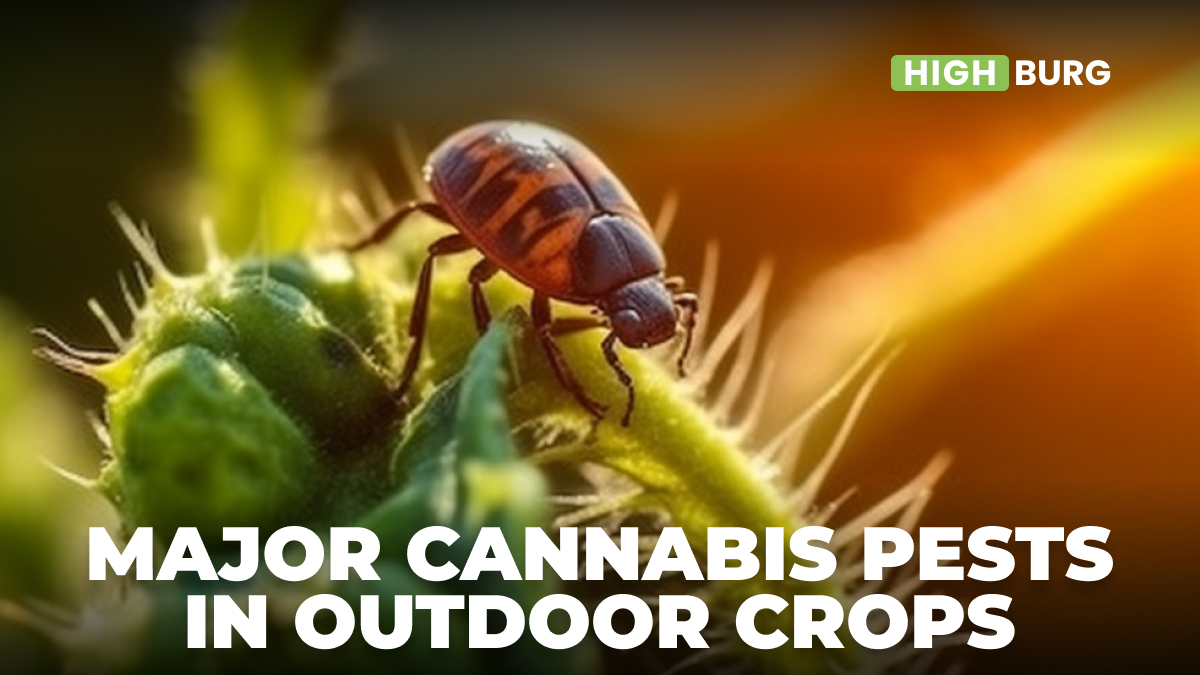When cannabis plants are grown outdoors, they are exposed to insects that can seriously affect the final crop quality and yield. Among the major cannabis pests there are:
- Spider mites;
- Thrips;
- Aphids;
- Fungus gnats;
- Caterpillars.
It’s important to monitor pests regularly and take action quickly in order to prevent an infestation from getting out of control. Discover the major common pests in outdoor cannabis crops and the natural and chemical pests control methods available to growers.
Spider mites
These tiny arachnids are typically less than 1mm in size. The two main species known to feed on cannabis are: the common two-spotted spider mite Tetranychus urticae and the clover mite Bryobia praetiosa. They are a common pest that can affect cannabis crops causing significant damages to the plant:
- the leaves will become yellow or brown
- inflorescences and leaves will be covered by webs
- the overall tone of the plant will decrease
- Poor yields quality
- Poor yields quantity
Spider mites can be particularly problematic for growers due to their capability to reproduce themselves fast creating large populations. They usually develop from egg to adult in ten days and tipically in warm and dry conditions. The adults usually live for around two weeks and the amount of eggs that females can lay are from 50 to more than 170. If not taken seriously and on time the outcome can be dramatic for the whole cannabis crop.
Spider mites control
In order to prevent a spider mites infestation, it is necessary to check the plants regularly. The presence of webs on inflorescences or leaves and the discoloration of them are clear signs of the presence of these arachnids.
Many biotic and abiotic approaches are valid solutions to face the spread of spider mites. Among chemical agents micronized sulfur can be a valid option to face spider mites if applied on non-flowering plants: this compound is capable of destroying the arachnis exoskeleton and reducing the populations immediately following application. Sulfur is a vaild agent also against microbial pests so it can be a valid comprehensive option to keep the cannabis crop safe.
Another option to face spider mite infestation is using biocontrol agents. Among predators of spider mites there are predatory mites such as Phytoseiulus persimilis and Neoseiulus californicus, ladybugs that feed on the mites and their eggs and so on.
Because of the easy spread of mites through wind or equipment, often physical barriers and an accurate hygiene routine of cultivation tools can be a valid way to prevent infestations. Using a fast-acting agent is crucial, and prevention is often more effective than waiting, regardless of the chosen method.
Thrips
Also known as thysanoptera or thunderflies, thrips are small insects capable of transmitting plant viruses and largely damaging the cannabis crop. They feed on the plant’s cells and they suck their content including chlorophyll. This leads to leaves silvering or discoloration.
Moreover if the thrips are infected or the infestation is severe the leaves will progressively appear puckered and twisted, and the plant growth can also stop. Thrips leave on the surface and underside of leaves trace of black feces, coming from them or their larvae.
As mentioned before, thrips can be vectors of transmission of plant viruses such as the tomato spotted wilt virus (TSWV) and the impatiens necrotic spot virus (INSV) , both of which can infect cannabis plants having a critical impact on the crop.
Thrips control
In order to control thrips populations there are several methods exist.
Through the introduction of natural predators it’s possible to operate a biological control over thrips spread. Predatory mites feeding on thrips, their larvae and eggs can be a successful way to reduce the number of this pest. Megaphragma mymaripenne, are small wasps that can be introduced in the crop to reduce considerably the number of thrips larvae.
Moreover it is possible to use various chemicals against thrips including:
- Pyrethrins;
- Rotenone;
- Potassium soap;
- Neem oil.
The application of these biological products can be repeated every two or three days. It should be remembered to always control the underside of leaves to check the presence of eggs and larvae that can potentially start a new thrips spread.
The infested leaves can be pruned off and sticky traps can be placed to catch this pest and control also the population of other undesired insects.
Another mechanical way to remove thrips is to spray them off with water or using vacuum.
Aphids
Among the predominant pests with piercing-sucking mouthparts there are aphids. The most well known species present in cannabis crops are:
- Phorodon cannabis
- Myzus persicae
- Aphis fabae
These insects can infest the plant, feeding predominantly on leaves, but also stems, flowering tops and unripe seeds.
Aphids can cause serious problems such as stunted growth, wounds on leaves and they secrete honeydew on buds promoting fungi and ants infestations. Aphids can vector viruses, bacteria and fungi from diseased plants to healthy ones, potentially affecting the total crop if not spotted on time. Among the viruses that can be transmitted to cannabis plants there are the hemp streak virus, the hemp mosaic virus, hemp leaf chlorosis virus, cucumber mosaic virus, hemp mottle virus and the alfalfa mosaic virus (AMV).
They prefer humid and warm environments and their presence can be due to various factors including the over-fertilization of plants, poor sanitation of cultivation tools and the lack of natural predators such as ladybugs, lacewings and parasitic wasps.
Aphids control
If you spot this pest on your cannabis plant you can quickly prune off the infested plant parts in order to reduce the risk of spreading to the whole crop.
Rapeseed oil can be sprayed to asphyxiate aphid eggs or organic pyrethrins can be used. If the plants are already in the flowering stage it’s better to use compounds such as neem oil without the risk of the plant absorbing unwanted chemical traces.
Potassium soap can be employed to remove dead insects and the honeydew left on the leaves.
Natural remedies are useful against aphids including concoctions with tomato leaves, garlic extracts or tobacco leaves. These home remedies can be effective also against red spider mites. The removal of aphids can be also mechanical spraying them off with water. Nevertheless these methods can be efficient only if the infestation is not severe. Another method that can help control this pest is to introduce beneficial insects that feed on aphids such as ladybugs and lacewings.
Fungus gnats
These tiny flies are usually present close to the soil of your cannabis plants, especially if it is overwatered and persistently humid. Adult females lay 100 to 200 eggs after mating into the growing medium and with high temperatures the development of larvae can be very fast.
Even if they don’t directly damage the plant or bite people, their larvae can cause serious problems to the root system of the plant. Larvae eat roots, interfering with the plant’s ability to uptake water and nutrients, stunting plant growth and creating entry points for plant pathogens including Pythium, that can further harm the plants.
Common symptoms in cannabis plants with an infestation of fungus gnats are:
- yellowing leaves;
- wilting;
- reduced yield;
- plants death.
Fungus gnats control
In order to prevent the proliferation of fungus gnats larvae the most important thing is to conduct a good watering regime. Overwatering your plants or leaving the soil too moist could potentially lead to an infestation of this pest.
Place sticky traps near plant leaves in order to monitor the quantity of adults, while placing potato slices on the soil in order to attract larvae and check the number of them.
The bacterial-based insecticide Bacillus thuringiensis subsp. Israelensis is an effective larvicidal substance that helps to reduce the number of flying insects including fungus gnats. Make early applications of this insecticide to prevent infestation during crop production.
The implementation of sanitation and placing physical barriers on the growing medium surface can be also valid methods to prevent the spread of fungus gnats.
The release of biological control agents in early stages of plant growth can be a valid method to face the development of the larvae of fungus gnats. These include predatory mites such as Stratiolaelaps scimitus and the predatory rove beetle Dalotia coriaria, among others.
Caterpillars
A large caterpillar infestation can be a serious problem for your cannabis crop. After butterflies and moths depose their eggs on buds or leaves, the newborns will start eating your plant causing little holes on leaves but also damaging the buds and leading to inflorescence rot and even plant death.
Many types of caterpillars can infest cannabis crops including:
- Armyworm;
- Budworm;
- Cutworm;
- Corn earworm.
In addition to eating the plant and damaging buds and foliage, caterpillars’ fecal matter can contaminate the plant and affect the quality of the final crop. In fact caterpillar feces can contain harmful pathogens and bacteria such as E. coli and Salmonella among others which can pose a health risk to humans, particularly those with weakened immune systems.
Caterpillars control
The caterpillar biological insecticide containing the Bacillus thuringiensis (BT) bacteria kills butterfly larvae and while killing caterpillars it will not hurt beneficial insects. Humans can safely apply this compound during the flowering stage as it is not harmful.
Another organic pesticide made from the fermentation of soil bacteria Actinomycete Saccharopolyspora spinosa can successfully kill the caterpillars by affecting their nervous system .
As a biological control method many growers install nest boxes of caterpillar-eating birds such as sparrows, robins nearby and goldfinches. You can introduce predatory insects such as parasitic wasps and braconid wasps to control pests in the crop.
Another natural alternative involves planting thyme and basil plants besides our cannabis plants in order to repel the caterpillars, or planting cabbages or soybeans in order to attract them and leaving the cannabis plants safe.
A good option is to use pheromone traps to attract butterfly and moth males and reduce the possibility of reproduction.
Regular monitoring and early intervention can help minimize the damage and ensure a healthy and high quality cannabis crop.
Observations and conclusion
If you decide to use a chemical insecticide to remove pests on your cannabis plants it’s important to read the label carefully and to consider the fact that it could also harm beneficial insects.
Moreover sometimes chemical insecticides are highly toxic and a residue can stay in your cannabis inflorescences. Be sure to wear protective clothing and gloves and avoid using these kinds of insecticides during the flowering stage. Among the chemical insecticides you can use there are the carbamates, organophosphates, neonicotinoids, etc.
Whatever pest method control you will use it is always a good practice to spot on time the first signs of infestation in order to prevent the rapid spread of it that can have dramatic consequences on your final crop, both in terms of quality and quantity.
The important thing is to implement an integrated pest management strategy to control pests on your cannabis crops, using if possible a combination of cultural, physical, biological and chemical control methods as needed, while minimizing harm to the environment and beneficial insects.



